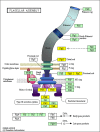Transcriptional regulation and adaptation to a high-fiber environment in Bacillus subtilis HH2 isolated from feces of the giant panda
- PMID: 25658435
- PMCID: PMC4319723
- DOI: 10.1371/journal.pone.0116935
Transcriptional regulation and adaptation to a high-fiber environment in Bacillus subtilis HH2 isolated from feces of the giant panda
Abstract
In the giant panda, adaptation to a high-fiber environment is a first step for the adequate functioning of intestinal bacteria, as the high cellulose content of the gut due to the panda's vegetarian appetite results in a harsh environment. As an excellent producer of several enzymes and vitamins, Bacillus subtilis imparts various advantages to animals. In our previous study, we determined that several strains of B. subtilis isolated from pandas exhibited good cellulose decomposition ability, and we hypothesized that this bacterial species can survive in and adapt well to a high-fiber environment. To evaluate this hypothesis, we employed RNA-Seq technology to analyze the differentially expressed genes of the selected strain B. subtilis HH2, which demonstrates significant cellulose hydrolysis of different carbon sources (cellulose and glucose). In addition, we used bioinformatics software and resources to analyze the functions and pathways of differentially expressed genes. Interestingly, comparison of the cellulose and glucose groups revealed that the up-regulated genes were involved in amino acid and lipid metabolism or transmembrane transport, both of which are involved in cellulose utilization. Conversely, the down-regulated genes were involved in non-essential functions for bacterial life, such as toxin and bacteriocin secretion, possibly to conserve energy for environmental adaptation. The results indicate that B. subtilis HH2 triggered a series of adaptive mechanisms at the transcriptional level, which suggests that this bacterium could act as a probiotic for pandas fed a high-fiber diet, despite the fact that cellulose is not a very suitable carbon source for this bacterial species. In this study, we present a model to understand the dynamic organization of and interactions between various functional and regulatory networks for unicellular organisms in a high-fiber environment.
Conflict of interest statement
Figures



Similar articles
-
Cellulose-dependent expression and antibacterial characteristics of surfactin from Bacillus subtilis HH2 isolated from the giant panda.PLoS One. 2018 Jan 31;13(1):e0191991. doi: 10.1371/journal.pone.0191991. eCollection 2018. PLoS One. 2018. PMID: 29385201 Free PMC article.
-
[Isolation, identification and cellulase production of a cellulolytic bacterium from intestines of giant panda].Wei Sheng Wu Xue Bao. 2012 Sep 4;52(9):1113-21. Wei Sheng Wu Xue Bao. 2012. PMID: 23236845 Chinese.
-
Complete genome sequence and comparative genome analysis of Klebsiella oxytoca HKOPL1 isolated from giant panda feces.BMC Res Notes. 2014 Nov 23;7:827. doi: 10.1186/1756-0500-7-827. BMC Res Notes. 2014. PMID: 25417012 Free PMC article.
-
Generation of multiple cell types in Bacillus subtilis.FEMS Microbiol Rev. 2009 Jan;33(1):152-63. doi: 10.1111/j.1574-6976.2008.00148.x. Epub 2008 Nov 19. FEMS Microbiol Rev. 2009. PMID: 19054118 Review.
-
Sporulation of Bacillus subtilis.Curr Opin Microbiol. 2004 Dec;7(6):579-86. doi: 10.1016/j.mib.2004.10.001. Curr Opin Microbiol. 2004. PMID: 15556029 Review.
Cited by
-
Selection of carbohydrate-active probiotics from the gut of carnivorous fish fed plant-based diets.Sci Rep. 2019 Apr 23;9(1):6384. doi: 10.1038/s41598-019-42716-7. Sci Rep. 2019. PMID: 31011158 Free PMC article.
-
Updating conservation metagenomics on the gut microbiome of threatened mammals.iScience. 2025 Jun 25;28(7):113000. doi: 10.1016/j.isci.2025.113000. eCollection 2025 Jul 18. iScience. 2025. PMID: 40687781 Free PMC article. Review.
-
Induction of Systemic Resistance in Maize and Antibiofilm Activity of Surfactin From Bacillus velezensis MS20.Front Microbiol. 2022 May 9;13:879739. doi: 10.3389/fmicb.2022.879739. eCollection 2022. Front Microbiol. 2022. PMID: 35615505 Free PMC article.
-
Dynamics of Gut Microbiome in Giant Panda Cubs Reveal Transitional Microbes and Pathways in Early Life.Front Microbiol. 2018 Dec 18;9:3138. doi: 10.3389/fmicb.2018.03138. eCollection 2018. Front Microbiol. 2018. PMID: 30619206 Free PMC article.
-
Maturation of the Goat Rumen Microbiota Involves Three Stages of Microbial Colonization.Animals (Basel). 2019 Nov 25;9(12):1028. doi: 10.3390/ani9121028. Animals (Basel). 2019. PMID: 31775375 Free PMC article.
References
-
- Zhan X, Li M, Zhang Z, Goossens B, Chen Y, et al. (2006) Molecular censusing doubles giant panda population estimate in a key nature reserve. Current biology 16: R451–R452. - PubMed
Publication types
MeSH terms
Substances
LinkOut - more resources
Full Text Sources
Other Literature Sources
Molecular Biology Databases
Research Materials

